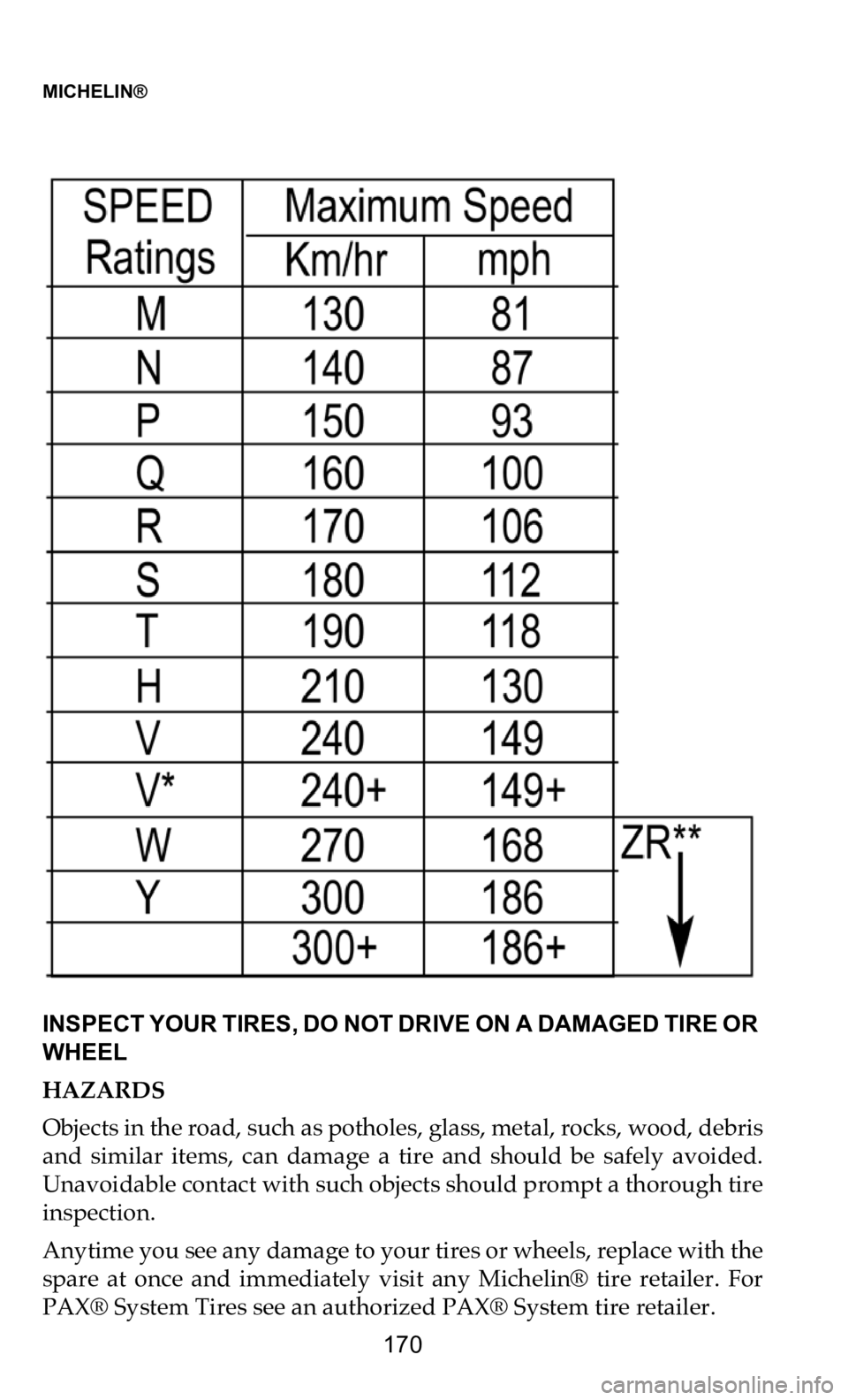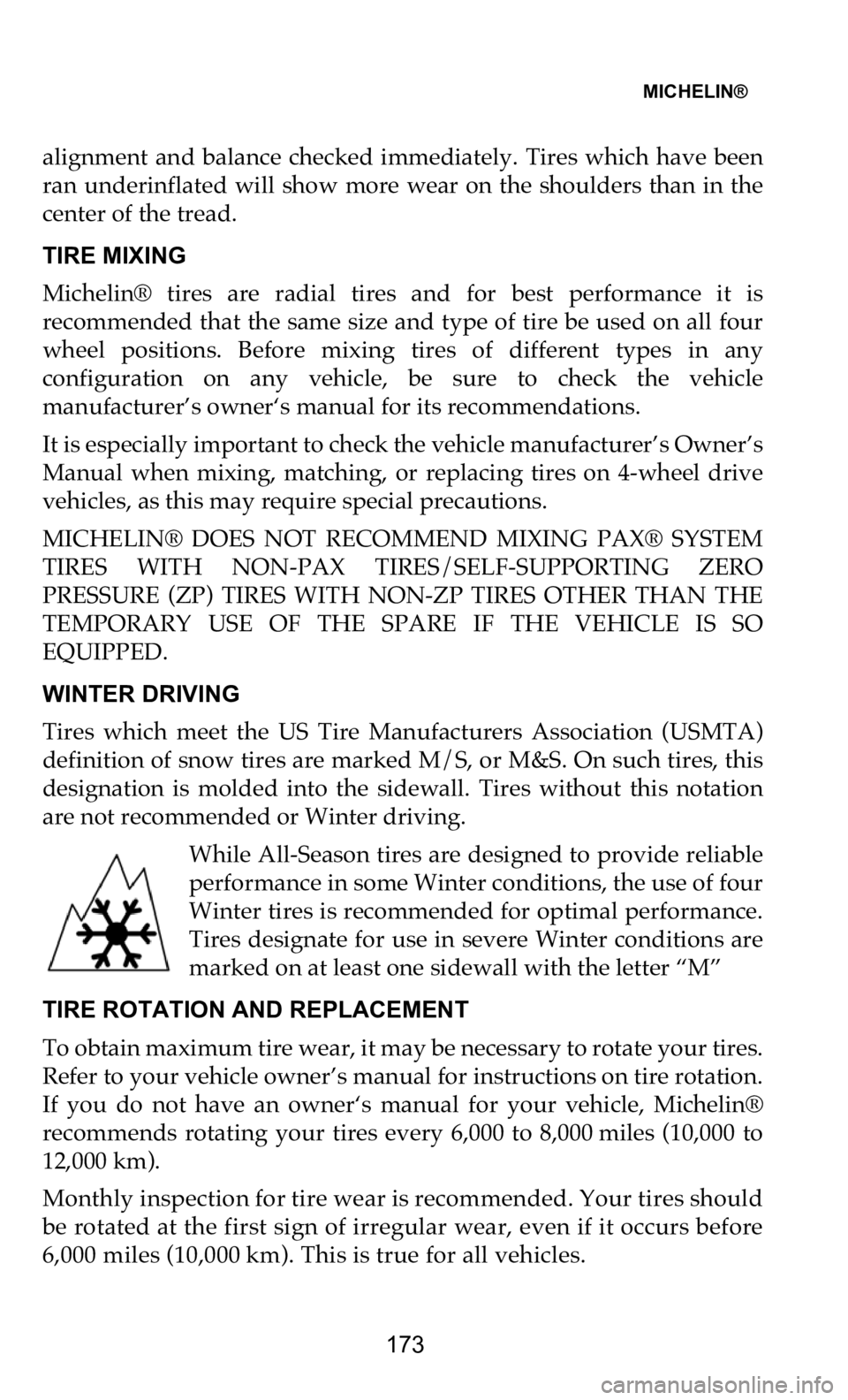DODGE DURANGO 2021 Vehicle Warranty
Manufacturer: DODGE, Model Year: 2021, Model line: DURANGO, Model: DODGE DURANGO 2021Pages: 262, PDF Size: 10.42 MB
Page 171 of 262

MICHELIN®
170
INSPECT YOUR TIRES, DO NOT DRIVE ON A DAMAGED TIRE OR
WHEEL
HAZARDS
Objects in the road, such as potholes, glass, metal, rocks, wood, debris
an
d similar items, can damage a tire and should be safely avoided.
Unavoidable contact with such objects should prompt a thorough tire
inspection.
Anytime you see any damage to your tires or wheels, replace with the
sp
are at once and immediately visit any Michelin® tire retailer. For
PAX® System Tires see an authorized PAX® System tire retailer.
Page 172 of 262

MICHELIN®
171
IMPACT DAMAGE
A tire impacted by a road hazard (curb, pothole, debris) may be
da
maged but not have visible signs of damage on its surface. A tire
damaged by an impact may sustain a sudden failure a day, week, or
even months later. You may not recall hitting an object that damaged
or injured your tires. Air loss, unusual tire wear, localized wear or
vibrations can also be signs of internal tire damage.
If you suspect any damage to your tire or wheel from an impact with
a
curb, pothole or debris on the road or any other road hazard, or if
you feel or hear any unusual vibration, replace with a properly
inflated spare at once and immediately visit any qualified tire
technician.
INSPECTION
When inspecting your tires, including the spare, check the air
pr
essures. If the pressure check indicates that one of your tires has lost
pressure of two pounds or more, look for signs of penetration, valve
leakage or wheel damage that may account for the air loss.
Always look for bulges, cracks, cuts, penetrations, and abnormal
ti
re wear, particularly on the edges of the tire tread, which may be
caused by misalignment or underinflation. If any such damage is
found, the tire must be inspected by any Michelin® tire retailer at
once. Use of a damaged tire could result in tire destruction.
All tires will wear out faster when subjected to high speeds as well as
ha
rd cornering, rapid starts, sudden stops, frequent driving on roads
which are in poor condition, and off road use. Roads with holes and
rocks or other objects can damage tires and cause misalignment of
your vehicle. When driving on such roads, drive carefully and slowly,
and before driving again at normal or highway speeds, examine your
tires for any damage, such as cuts, bulges, penetrations, unusual wear
patterns, etc.
WEAR-BARS
Michelin® tires contain “Wear-Bars” in the grooves of the tire tread
wh
ich show up when only 2/32nds of an inch (1.6 mm) of tread is
re
maining. At this stage, your tires must be replaced. Tires worn
beyond this stage are extremely dangerous.
Page 173 of 262

MICHELIN®
172
DO NOT OVERLOAD - DRIVING ON ANY OVERLOADED TIRE IS
DANGEROUS
The maximum load rating of your tires is molded on the tire sidewall.
Do
not exceed this rating. Follow the loading instructions of FCA US
LLC for your vehicle and this will ensure that your tires are not
overloaded. Tires which are loaded beyond their maximum allowable
loads for the particular application will build up excessive heat that
may result in sudden tire destruction.
Do not exceed the gross axle weight rating for any axle on your
ve
hicle.
TRAILER TOWING
If you anticipate towing a trailer, you should visit any Michelin® tire
re
tailer for advice concerning the correct size tire and pressures. Tire
size and pressures will depend upon the type and size of trailer and
hitch utilized, but in no case must the maximum cold inflation
pressure or tire load rating be exceeded. Check the tire decal and the
owner’s manual supplied by FCA US LLC for your vehicle for further
recommendations on trailer towing.
MICHELIN® PAX® System Tires/Self-Supporting Zero Pressure
(Z
P) Tires and Trailer Towing
Operation of Pax® or ZP tires at low or zero air pressure with a trailer
in
tow, is dangerous and is not recommended. If the low pressure
warning indicator is activated when a trailer is in tow, stop, disconnect
the trailer, and do not continue to tow the trailer until the tire has been
repaired and re-inflated to the proper air pressure. If the tire cannot be
repaired, it must be replaced with a new full size, PAX®/ZP tire, and
inflated to the proper air pressure, before the trailer can be safely
towed again.
WHEEL ALIGNMENT AND BALANCING ARE IMPORTANT
FO
R SAFETY AND MAXIMUM MILEAGE FROM YOUR TIRES.
CHECK HOW YOUR TIRES ARE WEARING AT LEAST ONCE
EA
CH MONTH
If your tires are wearing unevenly, such as the inside shoulder of the
ti
re wearing faster than the rest of the tread, or if you detect excessive
vibration, your vehicle may be out of alignment or balance. These
conditions not only shorten the life of your tires but adversely affect
the handling characteristics of your vehicle, which could be
dangerous. If you detect irregular wear or vibration, have your
Page 174 of 262

MICHELIN®
173
alignment and balance checked immediately. Tires which have been
ran underinflated will show more wear on the shoulders than in the
center of the tread.
TIRE MIXING
Michelin® tires are radial tires and for best performance it is
re
commended that the same size and type of tire be used on all four
wheel positions. Before mixing tires of different types in any
configuration on any vehicle, be sure to check the vehicle
manufacturer’s owner‘s manual for its recommendations.
It is especially important to check the vehicle manufacturer’s Owner’s
Ma
nual when mixing, matching, or replacing tires on 4-wheel drive
vehicles, as this may require special precautions.
MICHELIN® DOES NOT RECOMMEND MIXING PAX® SYSTEM
TI
RES WITH NON-PAX TIRES/SELF-SUPPORTING ZERO
PRESSURE (ZP) TIRES WITH NON-ZP TIRES OTHER THAN THE
TEMPORARY USE OF THE SPARE IF THE VEHICLE IS SO
EQUIPPED.
WINTER DRIVING
Tires which meet the US Tire Manufacturers Association (USMTA)
de
finition of snow tires are marked M/S, or M&S. On such tires, this
designation is molded into the sidewall. Tires without this notation
are not recommended or Winter driving.
While All-Season tires are designed to provide reliable
performance in some Winter conditions, the use of four
Wi
nter tires is recommended for optimal performance.
Tires designate for use in severe Winter conditions are
marked on at least one sidewall with the letter “M”
TIRE ROTATION AND REPLACEMENT
To obtain maximum tire wear, it may be necessary to rotate your tires.
Re
fer to your vehicle owner’s manual for instructions on tire rotation.
If you do not have an owner‘s manual for your vehicle, Michelin®
recommends rotating your tires every 6,000 to 8,000 miles (10,000 to
12
,000 km).
Monthly inspection for tire wear is recommended. Your tires should
be
rotated at the first sign of irregular wear, even if it occurs before
6,000 miles (10,000 km). This is true for all vehicles.
Page 175 of 262

MICHELIN®
174
When rotating tires with a directional tread pattern, observe the
arrows molded on the sidewall which show the direction the tire
should turn. Care must be taken to maintain the proper turning
direction.
Some Tire Pressure Monitoring Systems (TPMS) may not recognize
th
at a tire has been moved to a different position on your vehicle.
Make certain that your TPMS system is reset, if necessary, so as to
correctly identify the location of each tire on your vehicle. Refer to
your vehicle owner’s manual or your vehicle dealer.
Determine whether rotated tires require tire inflation adjustment as
fr
ont and rear position tire pressure may vary according to the vehicle
manufacturer’s specification due to the actual load on that wheel
position. Some vehicles may have different sized tires mounted on the
front and rear axles, and these different sized tires have rotation
restrictions. Always check the vehicle owner’s manual for the proper
rotation recommendations.
Full-size Spare
Full-size spare tires (not temporary spares) of the same size and
co
nstruction should be used in a five tire rotation. Always check the
inflation pressure of the full-size spare immediately before
incorporating it into rotation. Follow the vehicle manufacturer’s
recommended pattern for rotation, or if not available, see a qualified
tire technician.
Replacement of Two Tires
It is recommended that all four tires are replaced at the same time.
Ho
wever, when only two tires are replaced, the new tires should be
put on the rear. The new tires, with deeper tread, may provide better
grip and water evacuation in wet driving conditions.
CUSTOMIZATION OF TIRES, WHEELS, OR SUSPENSION ON
SU
VS AND LIGHT TRUCKS
Due to their size, weight and higher center of gravity, vehicles such as
SU
Vs and light trucks do not have the same handling characteristics
as automobiles. Because of these differing characteristics, failure to
operate your SUV/truck in a proper and safe manner can increase the
likelihood of vehicle rollover. Modifications to your SUV/truck tire
size, tire type, wheels or suspension can change its handling
characteristics and further increase the likelihood of vehicle rollover.
Whether your SUV/truck has the original equipment configuration
for tires, wheels and suspension or whether any of these items have
Page 176 of 262

MICHELIN®
175
been modified, always drive safely, avoid sudden, sharp turns or lane
changes and obey all traffic laws. Failure to do so may result in loss of
vehicle control leading to an accident and serious injury or death.
TIRE ALTERATIONS
Do not make or allow to be made any alterations on your tires.
Al
terations may prevent proper performance, leading to tire damage
which can result in an accident. Tires which become unserviceable due
to alterations such as truing, whitewall inlays, addition of balancing or
sealant liquids, or the use of tire dressing containing petroleum
distillates are excluded from warranty coverage.
REPAIRS WHEREVER POSSIBLE, SEE YOUR MICHELIN® TIRE
RE
TAILER AT ONCE
If any MICHELIN® tire sustains a puncture, have the tire demounted
an
d thoroughly inspected by any MICHELIN® tire retailer for
possible damage that may have occurred. A tread area puncture in
any MICHELIN® passenger or light truck tire can be repaired
provided that the puncture hole is not more than 1/4 inch in diameter,
no
t more than one radial cable per casing ply is damaged, and the tire
has not been damaged further by the puncturing object or by running
underinflated. Tire punctures consistent with these guidelines can be
repaired by following the US Tire Manufacturers Association
(USTMA) recommended repair procedures.
TIRE REPAIRS
Repairs of all tires must be of the combined plug and inside patch
ty
pe. Your MICHELIN® PAX® System tires must be removed from
the wheel for inspection prior to repair. Plug only repairs are
improper. A tire should be removed from the rim and inspected prior
to repair. Any tire repair done without removing the tire from the rim
is improper. An improperly repaired tire will cause further damage to
the tire by either leaking air or allowing air, moisture and
contaminants to enter the structure of the tire. An improperly repaired
tire can fail suddenly at a later date.
Never repair a tire with less than 2/32nds of an inch tread remaining.
At
this tread depth, the tire is worn out and must be replaced.
STORAGE
Tires contain waxes and emollients to protect their outer surfaces from
oz
one and weather checking. As the tire rolls and flexes, the waxes
and emollients continually migrate to the surface, replenishing this
Page 177 of 262

MICHELIN®
176
protection throughout the normal use of the tire. Consequently, when
tires sit outdoors, unused for long periods of time (a month or more)
their surfaces become dry and more susceptible to ozone and weather
checking and the casing becomes susceptible to flat spotting. For this
reason, tires should always be stored in a cool, dry, clean, indoor
environment. If storage is for one month or more, eliminate the
weight from the tires by raising the vehicle or by removing the tires
from the vehicle. Failure to store tires in accordance with these
instructions could result in damage to your tires or premature aging
of the tires and sudden tire failure.
When tires are stored, be sure they are placed away from sources of
he
at and ozone such as hot pipes and electric generators. Be sure that
surfaces on which tires are stored are clean and free from grease,
gasoline or other substances which could deteriorate the rubber. Tires
exposed to these materials during storage or driving could be
subject to sudden failure.
FOLLOW THESE MOUNTING RECOMMENDATIONS
Tire changing can be dangerous and must be done by professionally
tr
ained persons using proper tools and procedures as specified by
the Rubber Manufacturers Association (RMA). PAX® System tires
must be mounted and dismounted only by specially trained,
authorized PAX System retailers, utilizing PAX® System
authorized equipment.
Your tires should be mounted on wheels of correct size and type and
wh
ich are in good, clean condition. Wheels that are bent, chipped,
rusted (steel wheels) or corroded (alloy wheels) may cause tire
damage. The inside of the tire must be free from foreign material.
Have your retailer check the wheels before mounting new tires.
Mismatched tires and rims can explode during mounting. Also,
mismatched tires and rims can result in dangerous tire failure on the
road. If a tire is mounted by error on the wrong-sized rim, do not
remount it on the proper rim, scrap it. It may have been damaged
internally (which is not externally visible) by having been
dangerously stretched and could fail on the highway.
Old valves may leak. When new tubeless tires are mounted, have
ne
w valves of the correct type installed. Tubeless tires must only be
mounted on wheels designed for tubeless tires i.e., wheels which
have safety humps or ledges. As with any other tire air valve, the
PAX® System valve stem-pressure sensor combination must be in
Page 178 of 262

MICHELIN®
177
good condition to assure its performance. Always utilize valve caps
capable of containing the tire’s air pressure, should the valve core
leak. The valve cap is the primary seal against air loss.
It is recommended that you have your tires and wheels balanced. Tires
an
d wheels which are not balanced may cause steering difficulties, a
bumpy ride, and irregular tire wear.
SPECIAL MOUNTING INSTRUCTIONS FOR PAX® SYSTEM TIRES
PAX System wheels are different from all other wheels. Never attempt
to
mount a non-PAX System tire on a PAX System wheel, or a PAX®
System tire on a non-PAX System wheel. Attempting to do so could
cause serious injury or death. All PAX System components (tire,
wheel, support ring, pressure sensor and gel) must be utilized. Never
utilize a PAX System tire and wheel without every other properly
functioning component part, correctly installed by an Authorized
PAX System retailer. The PAX System must be used on all wheel
positions.
After a low or zero pressure driving event, the PAX System tire and
wh
eel may be hot to the touch. Always allow a PAX® System tire to
cool before attempting to handle it. Failure to do so could result in
injury.
SPECIAL MOUNTING INSTRUCTIONS FOR SELF-SUPPORTING
ZE
RO PRESSURE™ (ZP) TIRES
ZP tires can be more difficult to mount than conventional tires. They
sh
ould be mounted and demounted only by a properly trained tire
professional. ZP tires can generate a tremendous amount of heat when
run at low or zero pressure. ALWAYS ALLOW A ZP TIRE TO COOL
BEFORE ATTEMPTING TO HANDLE IT. FAILURE TO DO SO
COULD RESULT IN INJURY.
MICHELIN® ZP tires are tubeless tires designed to operate in
em
ergency conditions at low or zero air pressure.
MICHELIN® SELF SUPPORTING Zero Pressure™ (ZP) TIRES AND
SP
ECIAL SYMMETRIC HUMP-MODIFIED (SH-M) WHEELS
Some MICHELIN® ZP tires can only perform with zero pressure
ca
pability when mounted on special SH-M wheels. These tires bear
the SH-M designation immediately following the ZP designation on
the sidewall of the tire. DO NOT MOUNT ZP TIRES WITH THE SH-M
DESIGNATION ON STANDARD WHEELS. IN SUCH
Page 179 of 262

MICHELIN®
178
APPLICATIONS, THE TIRES MAY BECOME UNSERVICEABLE AT
LOW OR ZERO PRESSURE, CAUSING SERIOUS PERSONAL
INJURY OR DEATH.
SPECIAL MOUNTING INSTRUCTIONS FOR MICHELIN® TRX™
TI
RES
The MICHELIN® TRX™ tire is a tubeless tire that must only be
mo
unted on special wheels (TR or JM type) with millimetric seat
diameter. If TRX tires are mounted on standard wheels, they will not
retain air due to an air escape feature designed into the bead area of
these tires.
Do not try to override this feature by mounting TRX tires with
tu
bes. The MICHELIN® TRX™ tire must be used on all wheel
positions.
TEMPORARY TYPE SPARE TIRES
When using any temporary type spare tire, be sure to follow the
ve
hicle manufacturer’s instructions.
READING THE DOT
DOT XXXX XXXX XXX (prior to August 2000)
DOT XXXX XXXX XXX (1990-1999)
DOT XXXX XXXX XXXX (after July 2000)
THE DOT
The “DOT” symbol certifies tire manufacturer’s compliance with US
De
partment of Transportation tire safety standards. Next to the
symbol is the tire identification or “serial number”. The first two
characters identify the plant where the tire was manufactured. The
next two characters reflect the tire size. The following one to four
digits may be used at the tire manufacturer’s option as a descriptive
code. The last three characters are numbers identifying the week and
year of manufacture. (Example: “O25” means second week of the year
of decade, eg.: 1995, 1985, etc.) For the 1990-1999 decade MICHELIN®
brand tires are marked with a triangle pointing to the last three
numeric characters. Tires produced after July 2000 have an additional
digit to identify a given decade. For example, 2800 means the tire was
pr
oduced during the 28th week of 2000; 0201 during the 2nd week of
2001. If the last digits of your DOT number contains three numeric
characters and is not marked with a triangle, consult a qualified tire
technician to determine the year of manufacture.
Page 180 of 262

MICHELIN®
179
SERVICE LIFE FOR PASSENGER CAR AND LIGHT TRUCK TIRES
INCLUDING SPARE TIRES
The following recommendation applies to passenger car and light
tr
uck tires. Tires are composed of various types of material and rubber
compounds, having performance properties essential to the proper
functioning of the tire itself. These component properties evolve over
time. For each tire, this evolution depends upon many factors such as
weather, storage conditions, and conditions of use (load, speed,
inflation pressure, maintenance etc.) to which the tire is subjected
throughout its life. This service-related evolution varies widely so that
accurately predicting the serviceable life of any specific tire in advance
is not possible.
That is why, in addition to regular inspections and inflation pressure
m a
intenance by consumers, it is recommended to have passenger car
and light truck tires, including spare tires, inspected regularly by a
qualified tire specialist, such as a tire dealer, who will assess the tire’s
suitability for continued service. Tires which have been in use for five
years or more should continue to be inspected by a specialist at least
annually. Consumers are strongly encouraged to be aware not only of
their tires’ visual condition and inflation pressure but also of any
change in dynamic performance such as increased air loss, noise or
vibration, which could be an indication that the tires need to be
removed from service to prevent tire failure. It is impossible to predict
when tires should be replaced based on their calendar age alone.
However the older a tire the greater the chance that it will need to be
replaced due to the service-related evolution or other conditions
found upon inspection or detected during use.
While most tires will need replacement before they achieve 10 years,
i t
is recommended that any tires in service 10 years or more from the
date of manufacture, including spare tires, be replaced with new tires
as a simple precaution even if such tires appear serviceable and even
if they have not reached the legal wear limit. For tires that were on an
original equipment vehicle (i.e., acquired by the consumer on a new
vehicle), follow the vehicle manufacturer’s tire replacement
recommendations, when specified (but not to exceed 10 years).
The date when a tire was manufactured is located on the sidewall of
ea
ch tire. Consumers should locate the Department of Transportation
(DOT) code on the tire which begins with DOT and ends with the
week and year of manufacture. For example, a DOT code ending with
“2204” indicates a tire made in the 22nd week (May) of 2004.